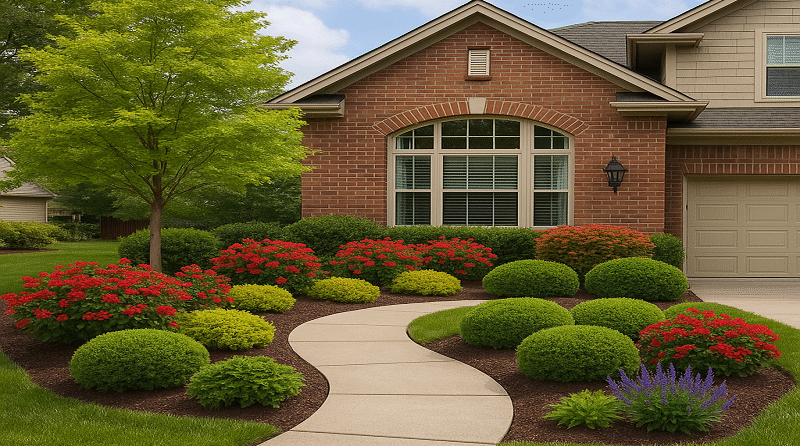Keeping your landscape pristine year-round requires more than occasional lawn mowing. It takes a proactive, seasonal landscaping strategy tailored to your yard’s unique needs. Whether it’s prepping your property for spring growth or removing snow in winter, following a season-based checklist ensures your lawn, garden beds, and trees stay healthy and beautiful.
Let’s walk through what to do—and when to do it.
Spring Landscaping Tasks (March – May)
Spring is the season of renewal, making it the ideal time to prep your lawn and landscaping beds.
- Core Aeration and Dethatching help loosen compacted soil and improve air, water, and nutrient flow to grassroots.
- Overseeding and Fertilization strengthen existing grass and fill in bare spots for a thicker, greener lawn.
- Property Cleanup is essential to remove winter debris like fallen branches, dead leaves, and trash.
- Tree Cutting and Pruning promotes healthy growth and prevents potential hazards during storm season.
- For garden prep, consider Rototilling and Sod Rip-Outs if you plan to refresh your lawn or planting beds.
Summer Landscaping Tasks (June – August)
With intense heat and long daylight hours, summer focuses on upkeep and damage prevention.
- Stick to a consistent Lawn Mowing and Trimming schedule to maintain grass health and appearance.
- Install Rock and Mulch to help soil retain moisture and keep weeds at bay.
- Maintain your flower and shrub beds with regular Bed Maintenance.
- Gutter Cleaning prevents overflow and water damage during sudden summer storms.
- For privacy and visual appeal, continue Hedge & Bush Trimming to maintain shape and size.
Fall Landscaping Tasks (September – November)
Fall is the time to restore and prepare your landscape for winter dormancy.
- Perform another round of Overseeding and Fertilization to give your lawn a head start for next spring.
- Clear away leaves and debris through Property Cleanup and Junk Hauling to prevent mold or pest buildup.
- Schedule Tree Cutting and Stump Grinding before snow adds weight to vulnerable branches.
- Install Sod or prepare your soil with Rototilling—fall’s cooler weather and consistent rainfall make it ideal for root establishment.
Winter Landscaping Tasks (December – February)
While plant growth slows, winter landscaping ensures your property remains safe and accessible.
- Keep driveways and walkways clear with timely Snow Shoveling and Snow Plowing.
- Prevent slip hazards with Ice Removal services.
- Winter is also a great time to perform Tree Pruning while trees are dormant.
- Plan ahead by installing Landscape Fabric in beds to block early weed growth in spring.
Why Seasonal Landscaping Matters
- Boosts curb appeal and increases property value
- Prevents costly damage from weather or neglect
- Enhances plant health, growth, and longevity
- Keeps your outdoor areas safe and functional
Year-Round Extras to Consider
In addition to seasonal landscaping services, we offer:
- Fabric Installation for weed prevention
- Ongoing Bed Maintenance for vibrant plant life
- Reliable Junk Hauling and debris clearing
- Gutter and downspout Gutter Cleaning for proper drainage
Ready for a Healthier Landscape?
From spring lawn care to winter snow removal, our landscaping team is ready to support you in every season. Let us help you plan a customized landscaping maintenance schedule that fits your property and lifestyle.
FAQs
Q1. When should I schedule aeration and overseeding?
A: Early spring or fall are best, as the cooler temps and moisture support root development and seed germination.
Q2. Do I need seasonal property cleanups even if I mow regularly?
A: Yes. Mowing maintains grass height, but cleanups remove accumulated debris, weeds, and dead foliage that can hinder lawn health.
Q3. Is it okay to plant sod in late fall?
A: Yes. Cooler temps and rainfall help new sod roots establish before winter sets in.
Q4. How often should I trim hedges and bushes?
A: For most hedges and bushes, trimming 2–3 times per year—especially in late spring, mid-summer, and early fall—helps maintain shape and encourages healthy growth.
Q5. What’s the difference between dethatching and aeration?
A: Dethatching removes the thick layer of dead grass and roots on the surface, while core aeration perforates the soil to improve airflow and nutrient absorption below ground.


